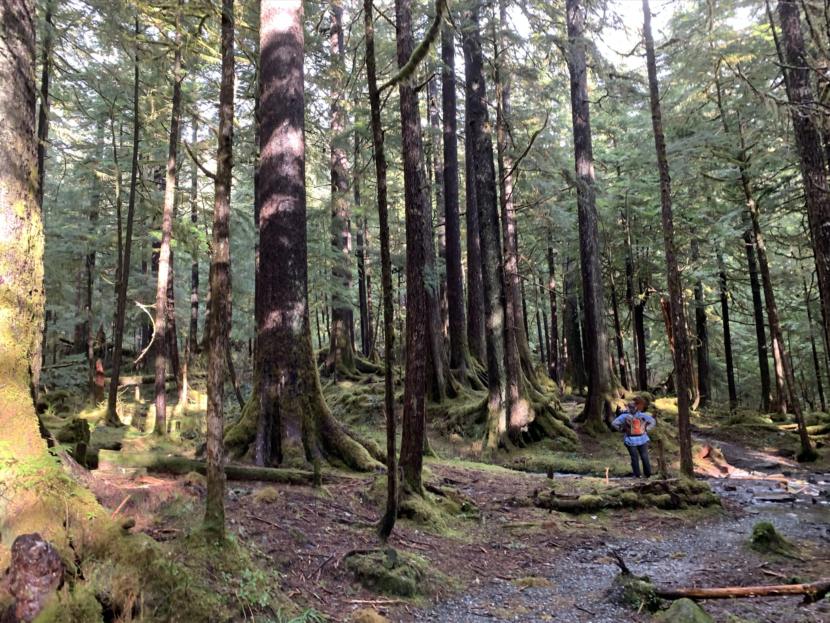
Tourism has replaced timber as the primary economic driver in many places around Southeast Alaska. And it’s a growing sector: Nearly 1.5 million people are forecast to visit the region this summer. But some residents don’t want to see tourists in places that often serve as refuges for locals.
Longtime Southeast resident Kathy Rousso is walking up Ketchikan’s Carlanna Lake Trail, clambering around a fallen tree blocking part of the trail and strolling onto a fishing pier.
Broken shards of ice cover the manmade lake just outside the Tongass National Forest. Until the late ‘80s, the reservoir served as Ketchikan’s primary water source. Today, though, Rousso says it’s just a great place to enjoy the natural beauty of Southeast Alaska.
“Like, for me, walking these trails is a mental — it kind of cleanses my mind, you know, it clears by head,” she said.
Rousso says it’s a great way to avoid the hustle and bustle of Ketchikan’s tourist-packed downtown. She says she comes out to Carlanna Lake on a fairly regular basis during the summer.
“It’s a kind of a local spot and it’s close to houses, you know, it’s in a neighborhood,” she said.
So Rousso was disappointed when she heard that a local company had applied for a permit to guide groups of tourists around the lake.
Teague Whalen is an English professor at the local University of Alaska Southeast campus and the owner and operator of Mindfulness Rainforest Treks, a Ketchikan-based hiking tour company. It’s a one-man operation. For the past half-decade or so, he’s guided small groups of visitors along Ketchikan-area trails. He says his customers choose a hike instead of more typical tourist activities in town for the same reason as locals like Rousso.
“Absolutely — the term that comes to my mind is ‘unplug.’ A lot of the customers I’ve had on the tours really appreciate getting away from all the people downtown,” he said.
But despite their common goal, Rousso says she doesn’t like seeing tourists on a neighborhood trail.
“I mean, if we’re walking up this road, and there’s a group of 20 people coming down the trail and a narrow trail, yeah, it really does kind of ruin the experience,” she said.
Rousso has other concerns, too. She’s afraid tourists might leave trash, clog up the 10-stall trailhead parking lot — or simply wear out the trail. She says she’s seen it happen elsewhere around Ketchikan.
But more than that, she wants a voice in the process.
“There needs to be more balance between the tourists and the locals, and I feel like we should be part of the decision-making on where those groups are going, and I don’t feel like we are,” she said.
Whalen says he’s sensitive to Rousso’s concerns.
“I get that as a local who uses those trails as well,” he said. “And so I think what needs to be happening more — and maybe this is a great way of opening that door — is to figure out some kind of multidisciplinary committee that is talking about, ‘what is a healthy balance for the tourism and local community?’”
He says even if that means more red tape, more paperwork and more permits, he’d be okay with that.
And he says residents have had their voices heard when it comes to keeping tours off trails. Many local trails, most of them on U.S. Forest Service land, don’t allow guided groups. And his company wouldn’t even be the first to guide tours on this neighborhood trail.
Whalen also says he’s not concerned about taking parking away from local hikers — he plans to take groups up to the trailhead in a single vehicle. And he says he’ll ensure guests don’t leave trash behind or venture off the developed trail.
Whalen says he’s caught in the middle of a debate happening in cruise ports all over Southeast: When it comes to tourism, how much is too much?
Back on the trail, Rousso says that even if more tour groups start making their way up toward Carlanna Lake, it beats at least one alternative.
“I guess I would rather have tour groups walking the trails than logging companies logging, cutting all the trees,” she said. “Because I think this forest has value.”
How to divide that value among locals, tourists and business owners, though, is an open question.
Residents can submit comments on the proposal until Monday, Feb. 10.
